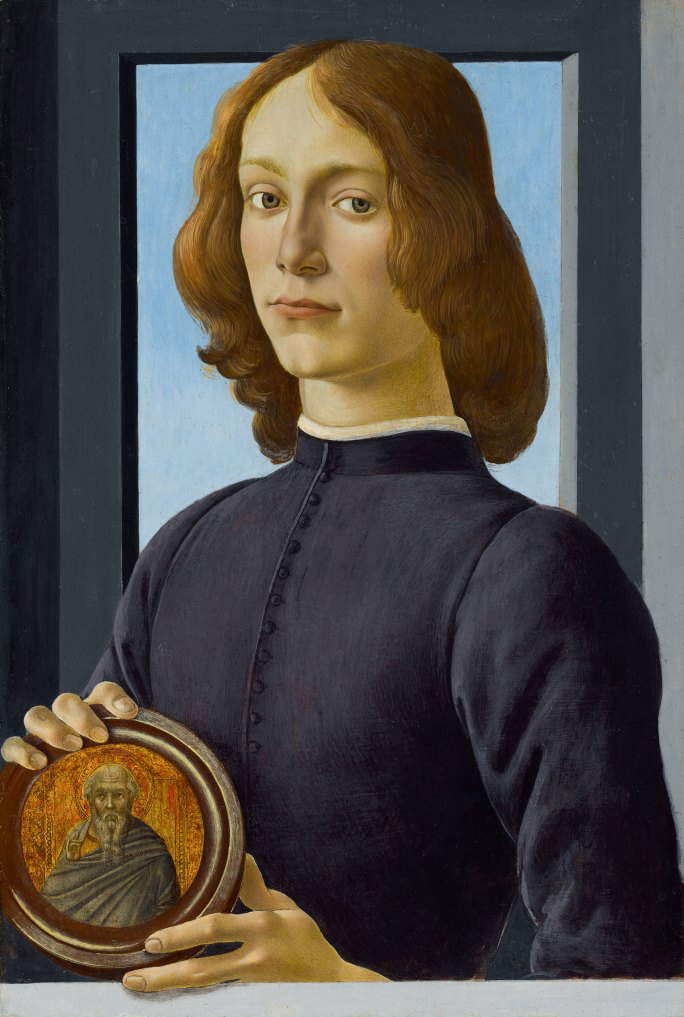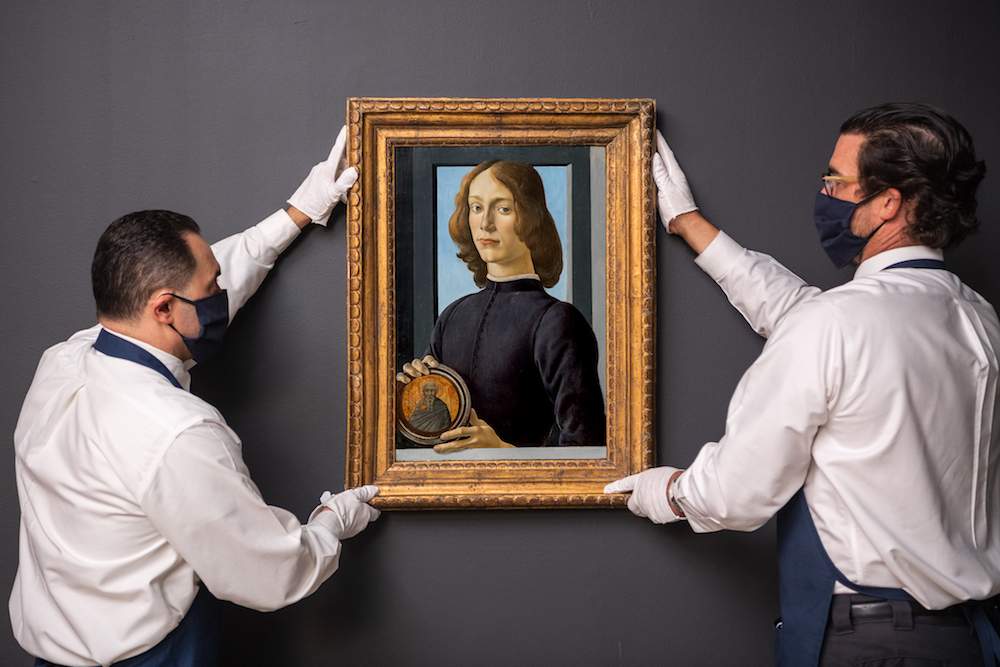Going up for auction at Sotheby’s in New York in January 2021 is the Portrait of a Young Man with Medallion, a work that in Anglo-Saxon circles is given with granitic certainty to Sandro Botticelli (Alessandro di Mariano Filipepi; Florence, 1445 - 1510), and this at least since 1987, when the painting was the subject of a study by art historian Richard Stapleford who, after a restoration, attributed it precisely to Botticelli. Italian scholars (Roberto Longhi first and Federico Zeri later), on the other hand, were more in favor of an attribution to Francesco Botticini (Florence, 1446 - 1497), on which Everett Fahy also agreed on the basis of the very strong resemblance to a portrait of Botticini kept at the Royal Palace in Stockholm. Another leading scholar, Ronald Lightbown, considered it to be the work of Botticelli’s school. However, the fact remains that the painting will be sold as a work by Botticelli, and it is possible that it will reach a very high adjudication figure. There is already talk of a possible $80 million sale: at the moment, however, Sotheby’s has not yet released the estimate. What can be said for now is that the record for a Botticelli work passed at auction is the $10.4 million at which the Madonna and Child with St. John was sold at Christie’s in 2013.
The Portrait of a Young Man with Medallion is certainly a very special and rare painting: it depicts a young man, clad in an elegant black corset, posing in front of a window open to a clear sky, while holding in his hands a medallion depicting a saint: it is an original 14th-century work, attributed to the Sienese painter Bartolomeo Bulgarini (Siena, c. 1300 - 1378), which the painter is said to have inserted into the portrait (although not everyone agrees: for Longhi, the insert was an “anti-historical” nonsense, and recently Keith Christiansen, another scholar according to whom the insert represents an anachronism, has also shown skepticism), and whose meaning still remains obscure, but, if it really was the artist’s idea, it is probably to be linked to the identity of the young nobleman depicted (also unknown).
The first mention of the painting dates back to the 1930s, when it was in Lord Newborough’s collection in Caernarvon, Wales: it was probably purchased by one of his ancestors, Sir Thomas Wynn, first Lord Newborough, at the time of a stay in Tuscany in the 18th century. The portrait was then sold to a private collector, who in turn sold it at auction in 1982 by Christie’s to the current owner, for the sum of £810,000. The public has had the opportunity to see the work in exhibitions held at the Royal Academy in London, the National Gallery in London, the Metropolitan in New York, the National Gallery in Washington (where it was exhibited from 1990 to 2013), and the Städel Museum in Frankfurt.
 |
| Sandro Botticelli (attr.), Portrait of a Young Man with Medallion (c. 1470-1480). |
Sotheby’s, with great emphasis, is already presenting the painting as The ultimate Renassaince portrait and letting it be known that it is a work that will make ancient art auction history anyway, as it is considered one of the most important portraits passed in an auction sale. The portrait, reads a Sotheby’s note, “is the pictorial synthesis of the ideals, magic and beauty of Renaissance Florence, where, for the first time since antiquity, the individual and the human figure were at the center of life and art, and would define the concept of humanism as we know it today. Botticelli was at the head of this movement, and his revolutionary style led him to be one of the first artists to abandon the tradition of portrait subjects in profile. And although it embodies the Florentine Renaissance, the painting has a timeless modernity because of its stark simplicity, its bright colors, and its linearism.” It was also difficult for the auction house to come up with a valuation, because in the Old Master sector there are no paintings comparable to this one that have been sold in the past, and consequently the estimate had to take into account logics involving sales between private individuals and sales of other portraits but from later periods.
The portrait in question has been juxtaposed with the very famous Portrait of a Young Man with Medallion by Cosimo de’ Medici in the Uffizi and the Portrait of Giuliano de’ Medici in the National Gallery in London, two works that can be dated to the late 1970s or early 1980s. As mentioned, the identity of the subject is unknown: with his sober dress he wanted to communicate modesty but at the same time elegance. Her attitude might suggest a connection to Neoplatonic theories and intellectual circles in Florence at the time, but nothing can be established with certainty. Similarly, it is not possible to see how well-founded are some of the hypotheses that, in the past, have advanced the name of Giovanni di Pierfrancesco de’ Medici, brother of Lorenzo il Popolano, that is, the cousin of the Magnifico for whom Botticelli painted the Primavera.
“In the common imagination, no other artist evokes the golden age of the Florentine Renaissance more than Botticelli,” says Christopher Apostle, head of Sotheby’s Old Masters department. "His Birth of Venus and his Primavera are among the most famous works in the Western art canon. His nymphs, goddesses, Madonnas and saints populate our imagination as representatives of the rebirth of science, arts and letters in a city that cradled the foundation of the modern world. However, it is in his portraits that Botticelli most clearly opens a window into the world of Renaissance Florence, and especially in Portrait of a Young Man with Medallion, a painting that conveys the intellectual, courtly and humanistic values that define the Italian Renaissance."
According to Sotheby’s experts, the attribution to Botticelli is corroborated by a number of reflectographs performed on the painting, which revealed a graphic structure believed to be typical of Botticelli’s method, and identified many details of the underlying drawing that differ from the final drafting (the most obvious being the shape of the hair and the position of the buttons on the robe)-a process of continuous revision that would reveal the artist’s perfectionism. According to Elisabeth Lobkowicz, Sotheby’s ancient art specialist, the painting is in an excellent state of preservation.
“Portraits are among the most powerful images ever created, resonating through the centuries,” said George Wachter, co-chair of Sotheby’s Old Masters. "Our young man today is 550 years old, but he looks like someone who may have strolled through our galleries this morning: he is an ageless beauty. This is a painting that transcends the normal boundaries of the Old Master genre, and it is one of the best-preserved and most delightful Renaissance portraits anyone would wish to own."
 |
| A portrait attributed to Botticelli for sale at Sotheby's: it will be a historic auction |
Warning: the translation into English of the original Italian article was created using automatic tools. We undertake to review all articles, but we do not guarantee the total absence of inaccuracies in the translation due to the program. You can find the original by clicking on the ITA button. If you find any mistake,please contact us.